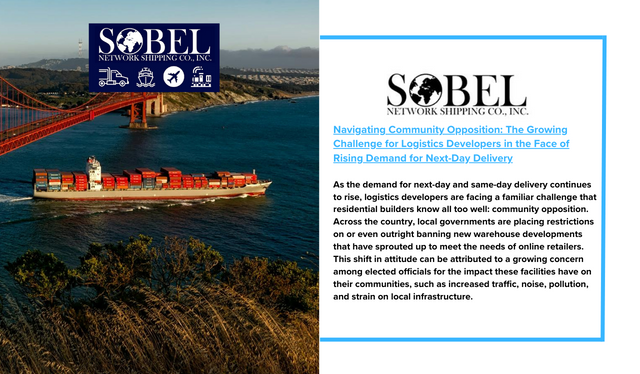As the demand for next-day and same-day delivery continues to rise, logistics developers are facing a familiar challenge that residential builders know all too well: community opposition. Across the country, local governments are placing restrictions on or even outright banning new warehouse developments that have sprouted up to meet the needs of online retailers. This shift in attitude can be attributed to a growing concern among elected officials for the impact these facilities have on their communities, such as increased traffic, noise, pollution, and strain on local infrastructure.
According to Seth Martindale, senior managing director in CBRE Group’s Americas consulting practice, the rising trend of “not-in-my-backyard” (NIMBY) sentiment is becoming a major issue. As he notes, “People want next-day delivery but they don’t want to see a distribution center next to them.” This sentiment was most recently evident in the village of Deerfield, Illinois, a predominantly residential community north of Chicago with a high per capita income. Despite the potential for job creation, the village rejected a proposal to convert a 101-acre corporate campus into a major logistics hub, which currently houses the headquarters of medical technology giant Baxter International.
In response to the growing opposition, the Deerfield village board passed even stricter zoning regulations on Tuesday, making it clear that logistics developers are not welcome in the community. While warehouses that store supplies for local businesses can still be approved, those designed for the constant influx of trucks carrying consumer goods will not be permitted. As Andrew Lichterman, Deerfield’s deputy village manager, explains, “We’re sending a clear message that developers should look elsewhere rather than asking us to change our zoning for logistics centers.”
The industrial real estate market has been a top performer in recent years, driven by the growing demand for e-commerce and the need for more distribution centers. However, the boom has led to a glut of warehouse space, and as a result, developers are now facing higher costs and longer delays due to community opposition. Additionally, conversion projects, which have been touted as a solution for repurposing aging corporate campuses and empty suburban office parks, are also facing roadblocks as local governments reject proposals for industrial use.
According to Vince Tibone, managing director at analytics firm Green Street, the growing resistance from communities has resulted in a longer and more complex approval process for developers. In areas such as New Jersey and the Inland Empire in southern California, where community opposition is particularly strong, construction starts have significantly dropped. Tibone also notes that the economic viability of conversion projects is entirely dependent on whether or not the local municipality grants the necessary permits.
This growing opposition is not limited to one region; it is a nationwide trend. As Tibone explains, “The higher the income level, generally the more opposition, the more nimbyism and the more resources they have to slow down or prevent industrial development.” Some governments are even blocking distribution centers because they are running out of land for commercial use and want to attract higher-paying office jobs instead.
Despite the challenges, market participants remain optimistic about the future of industrial development as long as the demand for online shopping continues to grow. According to Green Street, e-commerce requires three times the amount of logistics space compared to brick-and-mortar retail, and online sales are expected to increase by an average of 6.5% annually over the next five years. However, developers will need to navigate the growing opposition from communities, which may mean looking for alternative locations outside of highly desirable areas.
In conclusion, as the e-commerce boom shows no signs of slowing down, logistics developers will need to find ways to address the concerns of communities if they want to continue building warehouses and distribution centers. While the current environment may present challenges, it is also an opportunity for developers to showcase their commitment to responsible and sustainable development that is compatible with the needs and desires of local communities.


